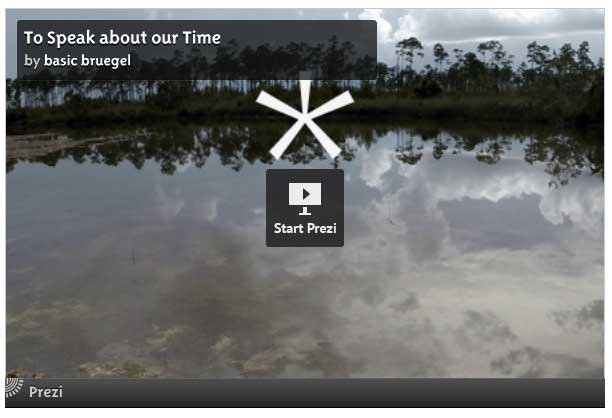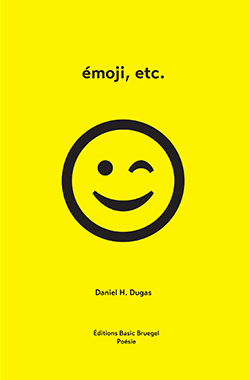Everglades: quand la poésie se porte à la défense de la nature (2018)
Par SYLVIE MOUSSEAUmardi 3 avril 2018
Acadie Nouvelle
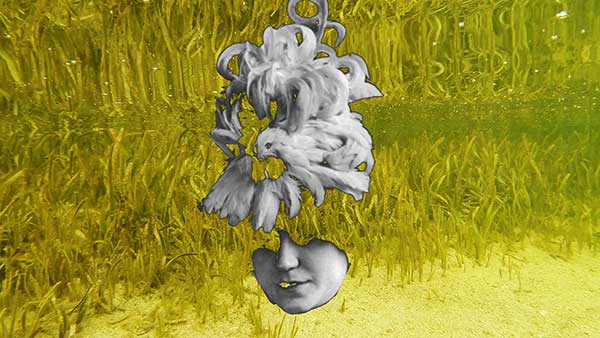
Véritable ode à la beauté et à la fragilité de l’environnement, le livre Evergladesde Daniel H. Dugas et Valérie LeBlanc qui allie photographie, poésie, récits narratifs et analyse nous transporte au cœur d’une nature menacée et marquée par le présence de l’être humain.
Les régions marécageuses constituent une source d’inspiration pour les artistes depuis longtemps. Dans cet essai poétique publié en français et en anglais chez Prise de parole, les auteurs de Moncton retracent en photo et en poésie leur expédition à travers le parc national des Everglades dans le sud de la Floride, tout en mettant en lumière leur approche artistique. Il figure parmi les plus grands parcs nationaux des États-Unis, avec 1,5 million d’acres. Le tandem d’artistes s’est attardé à la présence humaine et à son interaction avec l’environnement du parc.
«L’être humain est le pire des envahisseurs. C’est ce qui menace le plus la survie des espèces», a soulevé Daniel H. Dugas.
Malgré les efforts de restauration pour protéger l’écosystème du sud de la Floride, en 2010, l’UNESCO a remis les Everglades sur la liste des sites en péril. Valérie LeBlanc souligne que toute la canalisation des eaux construites dans le sud de la Floride a considérablement nui à la faune et à la flore de la région. Dans un des textes, Daniel H. Dugas et Valérie LeBlanc comparent les Everglades à un sablier, chaque grain de sable étant un animal.
«Nous le regardons se vider un battement d’aile à la fois un coup de nageoire à la fois. Quand la dernière espèce aura disparu que restera-t-il à documenter?» (extrait tiré du poème Une heure).
Le livre qui se déploie en trois volets rassemble des images traitées tirées de 12 vidéos poétiques, des poèmes, des récits, les photographies de 12 marches sonores et une section qui vient documenter le parcours des deux artistes. À la fois écrivains, poètes, artistes numériques, vidéastes et photographes, Valérie LeBlanc et Daniel H. Dugas livrent un ouvrage complet d’une belle ampleur qui documente toute la recherche qu’ils ont menée depuis quatre ans. Ces deux artistes qui forment aussi un couple dans la vie travaillent ensemble depuis de nombreuses années.
Fortement inspirés par les Everglades, ils ont commencé leur projet en 2014, lors d’une résidence d’un mois dans le parc au milieu de l’été. Dans ce climat subtropical, juillet est synonyme d’extrême chaleur, d’humidité et d’abondance de moustiques. Munis de leur caméra et vêtus d’habits antimoustiques, ils ont arpenté plusieurs régions du parc et des environs afin de créer leurs vidéos poétiques.
«Ce qui nous intéressait à chaque endroit, c’était la présence humaine que ce soit des ruines d’un ancien lieu, l’impact de l’être humain ou encore ce qu’ils font maintenant. On peut voir, entre autres, un lieu qui s’appelle Hole-in-the-Donut où il y avait une plante exotique – le Poivrier brésilien – qui a envahi le parc et les botanistes ont tout éradiqué la plante jusqu’à la pierre.»
Des ambassadeurs
Les deux artistes documentent la situation de façon poétique et visuelle. Le résultat est étonnant. Selon eux, l’art apporte un éclairage différent dans le discours environnemental et permet à la fois de montrer la fragilité et la résilience de la nature.
Le vidéopoète utilise différents procédés pour traiter l’image et ainsi créer des métaphores visuelles. Les marches sonores se basent davantage sur l’audio et les textes sont plus narratifs. Les deux artistes sont retournés à plusieurs reprises en Floride. Ils ont présenté leurs projets, leurs vidéos et ont participé à une exposition. Après les vidéos, ces deux spécialistes de l’art numérique ont eu envie de publier un livre, afin d’avoir un document permanent.
«On travaille beaucoup dans le numérique, ça dure un certain temps et après, ça passe, tandis qu’un livre on peut le garder tous les jours», a mentionné Valérie LeBlanc.
Le couple travaille à plusieurs projets géopoétiques, dont un sur la biosphère de la baie de Fundy. Daniel H. Dugas souligne qu’il y a plusieurs parallèles à faire avec les Everglades.
«Avec Fundy, on voulait faire un projet dans le lieu où nous vivons. Il y a quand même des liens intéressants avec la Floride, comme les oiseaux migrateurs, les courants marins, la fin des ouragans.»
Ce projet de vidéos poétiques devrait être complété d’ici la fin de l’année 2018 ou au début 2019.
«Avec ça, nous avons découvert beaucoup d’endroits que nous ne connaissions pas avant. Ce sont des endroits spectaculaires et on veut les montrer dans les vidéos», a ajouté Valérie LeBlanc.
Tiré en quantité limitée, le livre Everglades qui est disponible en librairie sera lancé le 26 avril, de 17h à 19h, à l’Hôtel Delta Beauséjour dans la cadre du Festival Frye à Moncton. Il y aura aussi un lancement à Miami en novembre prochain. À la suite du lancement à Moncton, tous les vidéos seront disponibles en ligne pour le public.
About Florida Bay (2017)
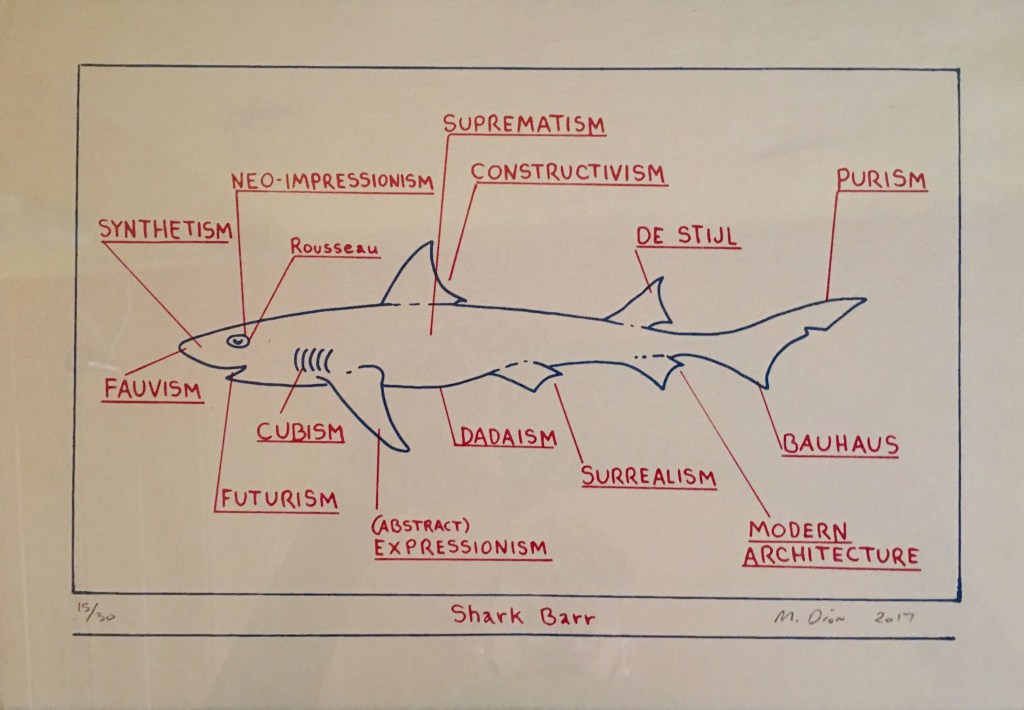
Airie Nest Exhibition: About Florida Bay
October 2017 – January 2018
We (Valerie LeBlanc and Daniel H. Dugas) are very happy that three of our Flow: Big Waters videos will be shown in the About Florida Bay exhibition.
The Florida Bay, located between the Everglades National Park and the Florida Keys, has undergone a series of ecological changes that have severely altered its natural ecosystem and resulted in a critical loss of native wildlife. This exhibition features select works which address the significance of this contested area and its precarious future, while recapturing its splendid past. AIRIE Fellows featured include Mark Dion, Valerie LeBlanc & Daniel H Dugas, Valerie George, Nick Gilmore, Jason Hedges and Magnus Sodamin.
http://airie.org/event/airie-nest-exhibition-about-florida-bay/
FLOW – daily features (2016)
Prompted by a 2014 tour through a missile launch site in the Everglades National Park, a woman reflects on the time when the Russian/Cuban/American nuclear standoff threatened to end life as we know it.
Valerie LeBlanc and Daniel H. Dugas
Soundmap: http://flow.basicbruegel.com/soundmap/
A mystery begins to form when a researcher finds uprooted plants on a Loop Road bridge. Tension mounts when a second car stops in that remote location.
Valerie LeBlanc and Daniel H. Dugas
Soundmap: http://flow.basicbruegel.com/soundmap/
There is one road that leads from the Everglades National Park entrance to Flamingo. There are no streets lights and at night, it is very dark.
Valerie LeBlanc and Daniel H. Dugas
Soundmap: http://flow.basicbruegel.com/soundmap/
The deer pen was built in July 1934. There are a few photographs depicting the area but little information exists on why it was built. Although it is located in the forest near a well-known trail, it is difficult to find.
Valerie LeBlanc and Daniel H. Dugas
Soundmap: http://flow.basicbruegel.com/soundmap/
Searching for a landmark in an overgrown setting, a woman is overcome by the atmosphere rising from the landscape.
Valerie LeBlanc and Daniel H. Dugas
Soundmap: http://flow.basicbruegel.com/soundmap/
Some people say that during the Cuban Missile Crisis, there were surveillance bunkers built along the Old Ingraham Road. Others deny the existence of such structures.
Valerie LeBlanc and Daniel H. Dugas
Soundmap: http://flow.basicbruegel.com/soundmap/
An abandoned mango forest is slipping back into the natural world. In July, the mango season is coming to an end and most of the fruit has fallen to the ground. Armed against the night with flashlights, two men set out into the rows of trees to find Burmese pythons
Valerie LeBlanc and Daniel H. Dugas
Soundmap: http://flow.basicbruegel.com/soundmap/
Nocturnal Desertion
Animals hiding in a deserted mango grove wait hopelessly for vindication.
Valerie LeBlanc and Daniel H. Dugas
Soundmap: http://flow.basicbruegel.com/soundmap/
Chekika the Zone
This area of the Everglades National Park has been closed since 2013. The gates are chained shut and the Rangers’ houses are boarded up. Chekika is a zone, the ruins of dreams.
Valerie LeBlanc and Daniel H. Dugas
Soundmap: http://flow.basicbruegel.com/soundmap/
Marion’s Car
Single lane and almost deserted, the Loop Road runs through the Big Cypress National Preserve. A sprinkling of people live there, mostly down narrow laneways that twist back into the trees. It has a reputation for being moonshine country.
Valerie LeBlanc and Daniel H. Dugas
Soundmap: http://flow.basicbruegel.com/soundmap/
The End of the World
July 8, 1905. The Bay is calm. The shore is a thin line of land, the sky faint blue, white. From Oyster Key, Flamingo appears to be a distant mirage.
Valerie LeBlanc and Daniel H. Dugas
Soundmap: http://flow.basicbruegel.com/soundmap/
FLOW – Launch (2016)
FLOW: BIG WATERS by Valerie LeBlanc and Daniel H. Dugas – Soundmap launch today.
12 soundworks inspired by geographic locations within the Everglades National Park, Big Cypress National Preserve and surrounding regions of South Florida and featuring the voices of Rebecca Rideout and Mark McPhee are available for listening.
http://flow.basicbruegel.com/soundmap/
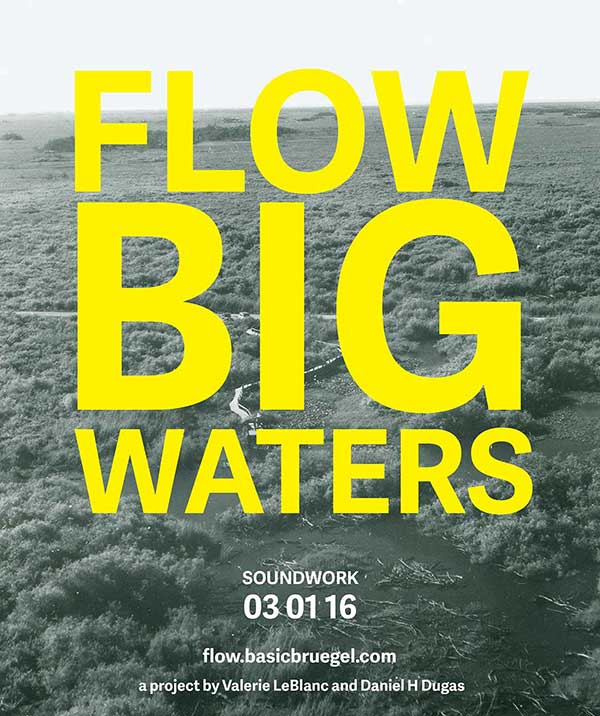
To Speak About Our Time (2015)
Transcript of Daniel Dugas’ talk given during the AnthropoScene, a semester-long exploration of this new era sponsored by the Leonard and Jayne Abess Center for Ecosystem Science & Policy and the College of Arts and Sciences of the University of Miami with participation by Artists in Residence in the Everglades.

TOP: The Trinity explosion, July 16, 1945; BELOW: The wolf of Hokkaido, the Tasmanian tiger and the Yangtze River dolphin.
The image of the first explosion of an atomic bomb to represent the beginning of the Anthropocene epoch is a dramatic choice. It is a powerful marker that can also remind us that what starts with a bang could also end with a whimper.
When I was first looking into the terminology for geological time scales, eras, periods and epochs, I was trying to visualize the latter part of the scale. Where are we in there? How do we fit in? What is the correlation between us and the bomb, the bomb and our daily life? If I was to transpose the atomic bomb into a in a more modest span of time, I would think that it would be like starting a new day by getting up on the wrong side of the bed, or worse by getting up only to trip on the carpet at the foot of the bed. The optimist in me says that it would only get better from there.
After taking care of this time scale concept, sort of, I started to worry about the implications of using such an image? What does it mean to have an atomic bomb symbolise the beginning of something? The images of the early blasts are still imprinted in our minds. I can still feel their heat and there is still a part of me that wants to run for cover under a desk or a table. The iconic charge of the bomb is still there and its power continues to frighten us all.
The Oomph Factor
There is a reason for everything. And the reason for choosing the atomic bomb as the icon for this epoch is fine. We all agree that it would have been less persuasive to have used an abstract rendition of a medical isotope. If radiation can be used to heat or to heal, it is also a metaphor for death and destruction, and this brings the atomic bomb, as an icon, much closer to the end of the world than the ‘radioactive substances used by health professionals to assist in the diagnosis and healing of certain health conditions.’ But is this the end of the world? Yes and no. For those who are going to disappear, it is. And we have seen countless of disappearances so far. The wolf of Hokkaido left us in 1889, the Tasmanian tiger in 1936, and the Yangtze River dolphin in 2007, among others. And there will be more species disappear from our world in the future.
Although the image shown suggests that the Anthropocene is the end of the world, it is not. Instead, it is a marker for a state of the world. It demonstrates the farthest we can go, the extreme limit of the human experience. The end of the world has a distance and a time frame attached to it. In the Everglades it was the name that the people living in what is now known as Flamingo thought the place should be called. It was about space. For the estimated between 90,000 – 166,000 people who died in the Hiroshima explosion, it was the end of time.
In 2004 I created the installation Nuclear Mickeys with an audio component entitled 666 seconds of hesitation. The sound track was based upon the Robert Oppenheimer “Now I am Become Death” recording.[1] The Nuclear Mickeys were nuclear explosions that got a fashion makeover for easy and safe consumption. I wanted to show how marketing swallows and dilutes meaning, making everything a game. I was fascinated by the silences and hesitations in Oppenheimer’s speech and based the soundtrack on them. The recording is 58 seconds in length; 28 seconds are comprised of silences, hesitations and breathing. I cut out the words and only kept these pauses. For me, these are the real messages, the heaviest messages.
I would like to draw your attention to this time-lapse map of Japanese artist Isao Hashimoto. It spotlights 2053 nuclear explosions that have taken place between 1945 and 1998.[2]
Alternative Symbol: Implosion vs. Explosion
So, we know the exact time and place of the first atomic bomb: July 16, 1945, at 5:29:45 a.m., Alamogordo, New Mexico. To be exact, the birth of the modern world is the Alamogordo Bombing and Gunnery Range (now known as the White Sands Missile Range), and in an ironic twist, owing to the Atari video game burial of 1983, Alamogordo could also be known as a mass grave of our modern world:
This was…a mass burial of unsold video game cartridges, consoles, and computers undertaken by American video game and home computer company Atari, Inc. in 1983. The goods disposed of through the burial were generally believed to have been unsold copies of E.T. the Extra-Terrestrial, a game which had become one of the biggest commercial failures in video gaming and is often cited as one of the worst video games ever released.[3]
If the bomb is a great source of inspiration and fascination you have to agree that the whole Atari burial thing is quite something as well. And the cherry on the cake goes to the Vice Admiral Blandy, and his wife cutting the Atomic Cake in a 1946 ceremony celebrating the first explosion in a post war era (peacetime). All is a question of perception and attitude.
End of the World Narrative vs. Speed of the World
The great acceleration of human activities that has been happening in the last 60 years has also transformed our perception of the world. But Speed is an interesting word. It means ‘rapidity of movement, quickness, swiftness’, but in old English SPED means ‘success, a successful course; prosperity, riches, wealth; luck; opportunity, advancement.’ [4] We thrive on speed, it is been the foundation of our modern world. And even if everything goes by faster and faster, we believe that everything will be okay. Everything has to be okay for things to go on. And we like things to go on. This message of hope is conveyed in every advertisement, in every slogan: Beyond Petroleum (bp), Make things better (Toyota), Solving Challenges (Halliburton) or Solutions are in our nature (David Suzuki) –all offer visions of optimism and possibilities.
In 2010, we all witnessed the Gulf of Mexico oil spill. For me, it was a watershed moment of great sadness. I was emotionally shaken by what I was seeing. Like many, I stood there powerless, watching the strange image of oil gushing out of a pipe. We were witnessing an endless leak of oil, right in the middle of the so-called Peak Oil period. What followed changed our perception of disaster. I think from that moment, no disaster would be seen the same way.
Two week after the blowout, I listened to the CBC (Canadian Broadcasting Corporation) interview with Dr. Overton, Professor Emeritus at Louisiana State University’s Department of Environmental Science. He spoke of the uncertainty and the scope of the event, noting that it would never be as big as the Exxon Valdez. The doctor talked about the oil spreading over a much longer period of time than the spill from the ill-fated tanker and explained how the effects would be less severe. He went on to compare the situation to a house fire saying that ‘a room might be on fire, but it doesn’t mean that the house is in danger.’ I was shocked to hear something like that. The doctor was actually comparing the oil spill and the Gulf of Mexico to the ‘room’ and the rest of the planet to the ‘house’, talking about the environment as a series of compartments, secluded from one another, with fire doors in between habitats, something like a weekly pill organizer.
And somehow the disaster went away. In mid August President Obama and his daughter Sasha were already swimming for the cameras at Panama City Beach. Normality prevailed.
Less than a year later, on March 11, 2011, we collectively witnessed the Fukushima Daiichi nuclear disaster. The meltdown of three of the plant’s six nuclear reactors was big news for a while, but this too went away. It did not take long for Japan’s Prime Minister, Shinzo Abe, to assure the International Olympic Committee that radiation leaks at the plant were ‘under control’. Eighteen months after the meltdown, the Olympic Committee announced that Tokyo (238 kilometres from Fukushima) would host the 2020 Summer Olympics. And suddenly, rapidly, successfully our planet becomes a house; we can close the Gulf of Mexico door or the Fukushima door and celebrate all that is good in the world. We would like to think that. Unfortunately, last week’s FUKUSHIMA UPDATE revealed that another pool of highly contaminated water was found to be leaking into the sea.[5] According to some, the final clean-up will take 40 years.
The lesson to be learned from both of these disasters is one of attitude and perception. If such disasters can occur so close to us, to them, and everything is fine, then we have to realize that the disasters to come have a serious benchmark to surpass in order to be qualified as worrisome. The earth can take it. She is tough. We’ll close the door or draw the curtains down.
Functions of the artist: Eye witnessing/investigating/reporting/
What can artists do, how can we contribute? Much like the artists sent on explorers’ ships, we can draw or take photographs of what we are seeing as a legacy for the future. Our function will be to document what is out there, but more importantly, we can keep the door open and make sure that the curtain stays up. Wassily Kandinsky said that artists have a responsibility to speak about their time, to speak about the spirit of their age. To paraphrase Roy – the leader of the renegade Nexus-6 Replicants in the movie Blade Runner, I will add that not speaking about our time here, would be like losing tears in the rain. If we take responsibly for something, we acknowledge that we can do something, and to forfeit this opportunity is like losing tears in the rain.
Daniel Dugas
March 4, 2015
University of Miami, FL
__________________________________________________________________
[1] Now I am become Death, the destroyer of worlds
“We knew the world would not be the same. Few people laughed, few people cried, most people were silent. I remembered the line from the Hindu scripture, the Bhagavad-Gita. Vishnu is trying to persuade the Prince that he should do his duty and to impress him takes on his multi-armed form and says, ‘Now I am become Death, the destroyer of worlds.’ I suppose we all thought that, one way or another.” Interview with J. Robert Oppenheimer about the Trinity explosion, first broadcast as part of the television documentary The Decision to Drop the Bomb (1965), produced by Fred Freed, NBC White Paper. https://www.youtube.com/watch?v=_LmxIptS3cw
[2] A Time-Lapse Map of Every Nuclear Explosion Since 1945 by Isao Hashimoto, 2003
About “1945-1998″ “This piece of work is a bird’s eye view of the history by scaling down a month length of time into one second. No letter is used for equal messaging to all viewers without language barrier. The blinking light, sound and the numbers on the world map show when, where and how many experiments each country have conducted. I created this work for the means of an interface to the people who are yet to know of the extremely grave, but present problem of the world.” http://www.ctbto.org/specials/1945-1998-by-isao-hashimoto/
[3] Atari video game burial
http://en.wikipedia.org/wiki/Atari_video_game_burial
[4] SPEED: Old English sped “success, a successful course; prosperity, riches, wealth; luck; opportunity, advancement,” from Proto-Germanic *spodiz (cognates: Old Saxon spod “success,” Dutch spoed “haste, speed,” Old High German spuot “success,” Old Saxon spodian “to cause to succeed,” Middle Dutch spoeden, Old High German spuoten “to haste”), from PIE *spo-ti-, from root *spe- (1) “to thrive, prosper” (cognates: Sanskrit sphayate “increases,” Latin sperare “to hope,” Old Church Slavonic spechu “endeavor,” Lithuanian speju “to have leisure”).
Meaning “rapidity of movement, quickness, swiftness” emerged in late Old English (at first usually adverbially, in dative plural, as in spedum feran). Meaning “rate of motion or progress” (whether fast or slow) is from c.1200. Meaning “gear of a machine” is attested from 1866. Meaning “methamphetamine, or a related drug,” first attested 1967, from its effect on users.
http://www.etymonline.com/index.php?term=speed&allowed_in_frame=0
[5] Fukushima Update nuclear news from japan
FukushimaUpdate.com went online on October 16, 2011. It is dedicated to providing news and information related to the nuclear crisis at the Fukushima Daiichi nuclear power plant in northeastern Japan. With neither a pro- nor anti-nuclear agenda and no axes to grind, Fukushima Update aims to be a one-stop source for reliable, fact-based reporting about the Fukushima situation.
Link to Valerie LeBlanc’s talk
AnthropoScene workshop (2015)
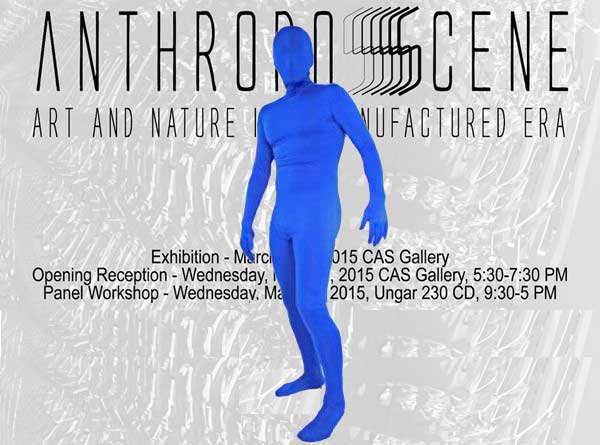
AnthropoScene – color keying workshop
Valerie LeBlanc and Daniel Dugas, University of Miami, FL – March 2015
MOVING IN THE LANDSCAPE: VISIBLE / INVISIBLE
This exercise in visual composition offers opportunities to discuss evidence of human passage in the natural landscape. During the editing process, each person will have access to the workshop footage. This will enable Students to further collaborate on the end result, or to compose individual works. Through voiceover, text over, and added music or sound compositions, the finished works will potentially convey a variety of messages related to the AnthropoScene Conference objectives.
The group will set up a tripod and camera in a fixed position facing a lush green area. (1) An establishing view of the scene will be recorded. (2) Volunteer(s) wearing the blue or white suit(s) will stand still in the green area. Once an image of the person(s) is recorded, recording will continue and the person(s) will move out of position. Volunteers will be encouraged to try out various ways of moving slowly through the scene.
In the editing process, the footage will be layered and color keying will be used to minimize the visibility of the figure(s). The desired effect in this DIY exercise will be an imperfect removal of the figure. (i.e. the keying effect sometimes leaves edge traces and this will reveal the movement of the figure.) Overall, the finished footage should reveal the outline of a (nearly invisible) figure moving in the landscape. During the editing process, Students will make decisions on what the final work will actually convey to the viewer.
AnthropoScene Schedule (2015)
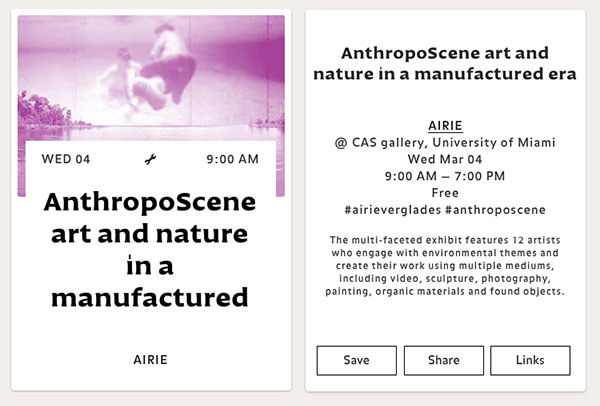
Exhibition March 4 – 24
CAS Gallery. 1210 Stanford Drive. Coral Gables, FL
Panel Discussion March 4 9am-12pm
Ungar Building 230 C/D. 1365 Memorial Drive
Lunch/Gallery Tour March 4 12:30-1:30 pm
CAS Gallery. 1210 Stanford Drive. Coral Gables, FL
Workshops March 4 2-5 pm
CAS Gallery. 1210 Stanford Drive. Coral Gables, FL
Opening Reception March 4 5:30-7:30 pm
CAS Gallery. 1210 Stanford Drive. Coral Gables, FL
SCHEDULE OF EVENTS
MARCH 4
PANEL DISCUSSION
UNGAR 230 C/D. 1365 MEMORIAL DRIVE. CORAL GABLES. FL
with artists
Daniel Dugas
Felice Grodin
Valerie LeBlanc
Lucinda Linderman
Deborah Mitchell
Skip Snow
Keith Waddington
8:30 am – 9:00 am Registration/Coffee Service
9:00 am – 9:15 am Welcome and plan for day: Gina Maranto and Keith Waddington
9:15-9:45 am Opening remarks: Skip Snow
9:45-10:00 Keith Waddington
10:00-10:30 Valerie LeBlanc and Daniel Dugas
10:30-10:45 Skip Snow
10:45-11:00 Break
11:00-11:30 Deborah Mitchell
11:30-12:00 Discussion with all artists moderated by Felice Grodin and Lucinda Linderman
WORKSHOPS AND EXHIBITION OPENING
CAS GALLERY. 1210 STANFORD DRIVE. CORAL GABLES. FL
with artists
Daniel Dugas
Felice Grodin
Valerie LeBlanc
Lucinda Linderman
Susan Silas
Skip Snow
Keith Waddington
12:30 pm – 1:30 pm Buffet Lunch and Tour
(Tour at 1 p.m.)
2:00 pm – 5:00 pm Concurrent workshop sessions
5:30 pm – 7:30 pm Opening reception: anthropoScene exhibition
anthropoScene is a semester-long exploration of this new era sponsored by the Leonard and Jayne Abess Center for Ecosystem Science & Policy and the College of Arts and Sciences of the University of Miami with participation by Artists in Residence in the Everglades.
Miami Report – Valerie LeBlanc and Daniel Dugas (2014)
Report from a visit to Miami and the Everglades National Park – Valerie LeBlanc and Daniel Dugas, November 2014
Our visit to South Florida to screen video poetry at the Miami Book Fair International and a visit to the Everglades National Park was short. Aside from the two days of air travel, we were there for just three days, really full days! To begin, on November 18, we screened several videos and took part in a panel discussion on the transformative effects that the July 2014 AIRIE (Artist In Residence In Everglades) residency had on our work. While our FLOW: BIG WATERS everglades-based project is ongoing and will eventually include an installation with soundwalks and photographs, we were happy to screen a selection of the video works that we have completed to this date.
The panel discussion was co-moderated by Artist and AIRIE Executive President, Deborah Mitchell and Biologist Skip Snow. The five AIRIE Artists who presented and took part in the discussion were: Gustavo Matamoros, Reed van Brunschot, Author Anne McCrary Sullivan, and ourselves. After brief introductions by Deborah Mitchell, Miami historian Dr. Paul George opened the conversation with details about the current and recent landmarks that stand and stood close to the Book Fair venue we were sitting within. Downtown Miami is undergoing many physical changes as new buildings replace older structures. Dr. George’s comments brought some of these changes to light. The evening took place at the SWAMP; the pop-up lounge utilized for showcasing social and cultural events during the Miami Book Fair International on the Miami Dade College, Wolfson Campus.
After the AIRIE presentation, Gustavo Matamoros and his partner, Miami-based Graphic Artist Claudia Ariano invited us to drive over to Little Havana’s El Cristo Restaurant to experience Cuban cuisine. The conversations continued in a range of topics that ran from contemporary art through a variety of cultural markers.
During two of our days, we walked around the Wolfson Campus and Miami’s downtown to become somewhat oriented with the city. We found our way over to the Miami Beach Mall for the opening of an umbrella of exhibitions at the ArtCenter of South Florida. The open studios and exhibitions for the 30 Years on the Road show spread out from 924 Lincoln Road, along the block to transform the experience from indoor venues to vitrines for sidewalk viewing. It is an ambitious undertaking that showcases retrospective and contemporary artworks embodying many genres. Outside of 924 Lincoln, the Listening Gallery, in partnership with Subtropics.org is presenting the collaborative work: Walk-Run. On opposite sides of the entrance doors, Walk-Run features face to face moving images by Charles Recher. Combined with a soundscape by Rene Barge and Gustavo Matamoros, Walk-Run can be experienced differently depending on if you are up-close to it, on the sidewalk in front of the building, or at distance. Turning the corner to view other artworks presented in vitrines also permits variable exposure to the audio as the sound waves bend around the architecture of the cityscape. Owing to the nature of showing so many artists at one time, the opening reception moved along the block with conversations continuing inside in and outside of the studios. Walking this stretch of the Mall with Gustavo, we met and talked with many artists. We also took time to view examples of art deco along the Lincoln Road Mall.
On November 20, the final day of our visit, Deborah Mitchell invited us to drive out to the AIRIE lab to visit November’s resident artist Regina Jestrow. Regina had generously organized an open studio reception in the lab where she laid out a sampling of the research she carried out during the month. It was a chance to talk informally with Regina, the other artists and scientists who dropped by, and several of the Park Staff that we had the pleasure of working with during July. We saw the beginning stages of Regina’s artworks utilizing imprinted rubbings and look forward to seeing the next stage of this new textile based work.
Back in Miami the same evening, we visited the Locust Project. Showing in the Main Space is Daniel Arsham’s Welcome to the Future. In the project room,Salvadorian artist Simón Vega’s exhibition Sub-Tropical Social Sculptures is ongoing.We arrived in time for the Art on the Move presentation with Curator Dominic Molon in conversation with Vancouver-based artist Ron Terada. The subject of the discussion was Terada’s Soundtrack for an Exhibition.
Our on-the-ground introduction to the Miami art scene gave us the chance to scratch the surface of this diverse, multicultural city where Spanish is the predominantly spoken second language. Staying in downtown Miami gave us the chance to see the last days of the old Miami Herald Building as it underwent demolition. It will be interesting to go back and see what new masterpiece rises to replace it on Biscayne Bay. If one word could be used to describe the face and evolving culture of Miami, vibrant would fit!



This activity was supported by the New Brunswick Arts Board


And the MBFI / The Swamp

AIRIE Panel @ MBFI (2014)
AIRIE Panel at Miami Book Fair International Highlights the Value of the Everglades
By Abel Folgar
Published Mon., Nov. 17 2014 at 8:05 AM
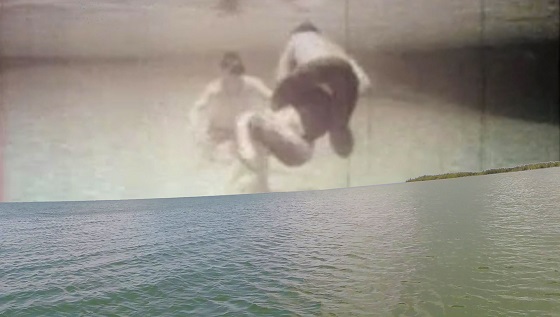
Courtesy of AIRIE LeBlanc and Dugas
For the last 14 years, the Artists in Residence in Everglades (AIRIE) has strengthened the bonds between science and art as a means of creating awareness and insuring the survival of the Everglades — a unique and delicate ecosystem that is unique and should be of utmost concern for all Floridians. Over the years, AIRIE has faced the same problems that routinely plague nonprofits but has continued to attract cutting-edge, contemporary artists to “mingle” with the Park’s scientific staff and create new works based solely on their experience in the residency.
Artist and Executive Director of AIRIE Deborah Mitchell will moderate a panel — Science + Art: Transformative Experiences in the Everglades — with an introduction by retired biologist Skip Snow, composed of the latest batch of artists who took up home in our beloved “swamp.” This diverse and multi-disciplined group of artists include Gustavo Matamoros, Valerie LeBlanc, Daniel Dugas, McCrary Sullivan and Van Brunschot regarding their work within the fragile ecosystem. Local historian Dr. Paul George will review the historical aspects of the Everglades.
We had a chance to speak with Mitchell about the program, its vision and what the future holds for the science and arts partnership in the Everglades.
See also: The Ten Best Things to Do at Miami Book Fair International

Courtesy of Deborah Mitchell
New Times: The Everglades are a unique ecosystem, the only one of its kind in the world. Why do you think it’s the immediate neighbors who are the most ignorant on its significance and importance to the well-being of Florida’s ecology?
Deborah Mitchell: The health and well-being of Florida’s ecology lies in the abundance of fresh, clean water. This complex issue often eludes the interest of the general public for many reasons, due largely to the misunderstanding of critical issues. Policy and legislation on the restoration is often challenging to comprehend, and on a more basic level most people don’t know much about the Biscayne Aquifer.
Think about the significance of our consumption in terms of drinking water, agriculture, tourism, and commercial fishing. It is almost impossible to measure the economic benefits of how we manage this critical resource.
What has been AIRIE’s biggest concern since its founding?
A huge challenge for AIRIE during 14 years of operation has been funding, as is the case with most nonprofits. Our budget operates in large part due to generous support from the John S. and James L. Knight Foundation, Tauk-Romano Innovative Philanthropy, community grants, and small, grass- roots fundraisers. The Board of Directors has recently expanded to include a high caliber of individuals, whose professional experience and visionary ideas will push the program forward. We have really rolled up our sleeves to increase exposure, hoping an endowment will assist us with maintaining a steady operating budget to fund our next set of goals.
You participated in an Artist-in-Residence program at Big Cypress back in 2007, what experiences there were you able to translate into working in the Everglades environment?
AIRIE is unique in that it has always been operated by artists; first by Donna Marxer in 2001, then by Christy Gast in 2009. We understand the needs of highly creative people and try to anticipate their needs, such as pre-arranging visits to the South Florida Collections Management Center for in-depth research. My experiences in Big Cypress continue to be intensely rewarding. Every summer I still venture out looking for ghost orchids with my friends and hike with my family in the winter. It is an honor to take AIRIE artists out in the field to meet with the locals, hike in the backcountry or kayak the Turner River in Big Cypress.
After all, the concerns of the Preserve and the Park are both centered around the flow of clean water from Lake Okeechobee southwards for our growing urban population. It is through cultural outreach events and programming that we expose the public to the interpretations of artists who have had the privilege of immersion in this subtropical wilderness. This will lead to a greater understanding of how vital it is to protect and preserve our precious natural resources.

Courtesy of AIRIE/Reed Van Brunschot
What has been the biggest impact of the program on the park?
In recent decades, artists have utilized the latest advances in science. The immense popularity of the new book Colliding Worlds, How Cutting Edge Science is Redefining Contemporary Art by Arthur Miller, proves that there is growing interest in the connection between the two fields. Enrollment in STEAM-related classes has increased, too. On March 4 at the University of Miami CAS Gallery, select AIRIE fellows will (together with local artists and scientists) lead a workshop and exhibition entitled AnthropoScene: Art and Nature in a Manufactured Era. When these types of partnerships emerge within our community, increased attendance and awareness of environmental issues impact the Park in a positive manner.
What type of artist is attracted to work in the Everglades and what can the park give said artist in return?
AIRIE receives applications from artists working in all disciplines who are seeking time to work unfettered by the demands of today’s fast paced world. The allure of the Everglades attracts artists who recognize this unique biosphere as a place so awe inspiring that it creates a stillness within. By achieving this personal transformation, an artist becomes free to process the experience and create new work in the AIRIELAB, our live/work space provided by the Park. The Park makes introductions between AIRIE Fellows and Park staff, assists with events, provides gear like bikes/kayaks, gets artists into the back country by letting them shadow scientists, and advises on the application proposals.
What can be expected from the panelists and how their diverse mediums have been affected by the park?
The Swamp panelists will be discussing how science and art can inspire transformative experiences in the wilderness. The diversity of mediums represented will ensure that there is something valuable for everyone’s tastes. We are absolutely thrilled to debut videos of Canadian team Daniel Dugas and Valerie LeBlanc entitled FLOW – BIG WATERS. In July 2014, this talented Canadian team worked in collaboration on the project in the Park recording and researching several aspects of this special biosphere. They are currently producing soundwalks to be made accessible to Park visitors online next year. Reed Van Brunschot, Gustavo Matamoros, and Anne McCrary Sullivan will also present and discuss their dynamic new work.
Overall, what do you want folks who learn about the program to come away with and what is the next step for AIRIE?
We hope to inspire people to get out and explore our wild peninsula, meet the artists, and think about how our short and long-term actions will affect the future generations. AIRIE is ready to increase its visibility and expand to a very strong and healthy organization. Come out and meet us at AIRIE in the Garden on January 24 from 2 to 5 p.m. at Pinecrest Gardens for our annual benefit! We will have live performances and readings featuring several artists from the 2014-15 program.
An Evening with AIRIE (Artists in Residence in Everglades) at Miami Book Fair International on Tuesday, November 18, at 7 p.m. at the Swamp Pavilion. Look for the big tent at the southeast corner of NE Third Street and Second Avenue. Call 305-237-3258 or visit miamibookfair.com.
Follow Cultist on Facebook and Twitter @CultistMiami.
Daniel H. Dugas
Archives
Blogroll
- A.I.R. Vallauris
- ACAD
- Adobe additional services
- Adobe Creative Cloud
- AIRIE
- Amaas
- Amazon Author Central
- ARTothèque
- Australian Poetry
- Basic Bruegel
- Bitly
- CCCA
- CDBaby
- Cycling 74
- Dissolution
- Éditions Prise de parole
- Emmedia
- eyelevelgallery
- FAVA
- Festival acadien de poésie
- Festival FRYE Festival
- FILE – Electronic Language International Festival
- Freeware list
- Fringe Online
- Galerie Sans Nom
- Gotta Minute Film Festival
- Instants Vidéo
- JUiCYHEADS
- Kindle Direct Publishing
- Klondike Institute of Art and Culture
- La Maison de la poésie de Montréal
- La Maison de la Poésie et de la Langue française Wallonie-Bruxelles
- Laboratorio Arte-Alameda
- Le Centre Jacques Cartier
- Liberated Words
- Maison Internationale de la Poésie – Arthur Haulot
- MediaPackBoard
- Miami Book Fair International
- Monoskop
- Mot Dit
- NSCAD University
- Paved Arts
- PoetryFilm
- Portail des auteurs du Nouveau-Brunswick
- RECF
- Revue Ancrages
- Salon du Livre du Grand Sudbury
- Sculpture Space
- Subtropics.org
- Sydney college for the arts
- The Centre for Contemporary Canadian Art
- The New Gallery
- Trevigliopoesia
- tumbler-documents
- V Tape
- Valerie LeBlanc
- VideoBardo
- Void Network-Κενο Δίκτυο
Categories
- #covidpoèmes
- Advertisement
- AIRIE
- Ancrages
- anthology
- Anthropocene
- Architecture
- Around Osprey
- art
- Article de presse
- arts visuels
- audio
- Australian Poetry
- Basic Bruegel Editions
- Book
- book fair
- Cafe Poet Program
- Ce qu'on emporte avec nous
- Citations gratuites
- Collaboration
- commentaire
- commentary
- Compte rendu
- conférence
- Conservation Foundation of the Gulf Coast
- COVID-19
- Critique littéraire
- culture
- Daniel Dugas
- Design
- Édition Michel-Henri
- Éditions Perce-Neige
- Éloizes
- Emmedia
- emoji etc | émoji etc
- Environnement
- essai
- essay
- Everglades
- Exhibition
- festival
- Festival acadien de poésie
- Festival Frye Festival
- FIPTR
- Flow: Big Waters
- Fundy
- Habitat
- installation
- Instants Vidéo
- interactivity
- journal
- JUiCYHEADS
- Kisii
- L'Esprit du temps
- laptop
- Leaving São Paulo
- lecture
- Livre
- logos
- Magazine
- Miami Book Fair
- Moncton 24
- novel
- OASIS
- oil spill
- perception
- performance
- Photo
- poésie
- Poetic Licence Week
- Poetry
- politics
- politique
- press
- Prise de parole
- Revue Ancrages
- salon du livre
- sculpture
- Sculpture Space
- sound
- Souvenirs
- Spirit of the Time
- Style & Artifacts
- Symposium d'art/nature
- talk
- television
- The New Gallery
- Uncategorized
- Valerie LeBlanc
- vidéo
- vidéopoésie
- Videopoetr/Vidéopoésie
- videopoetry
- visual arts
- What We Take With Us
- youth literature






